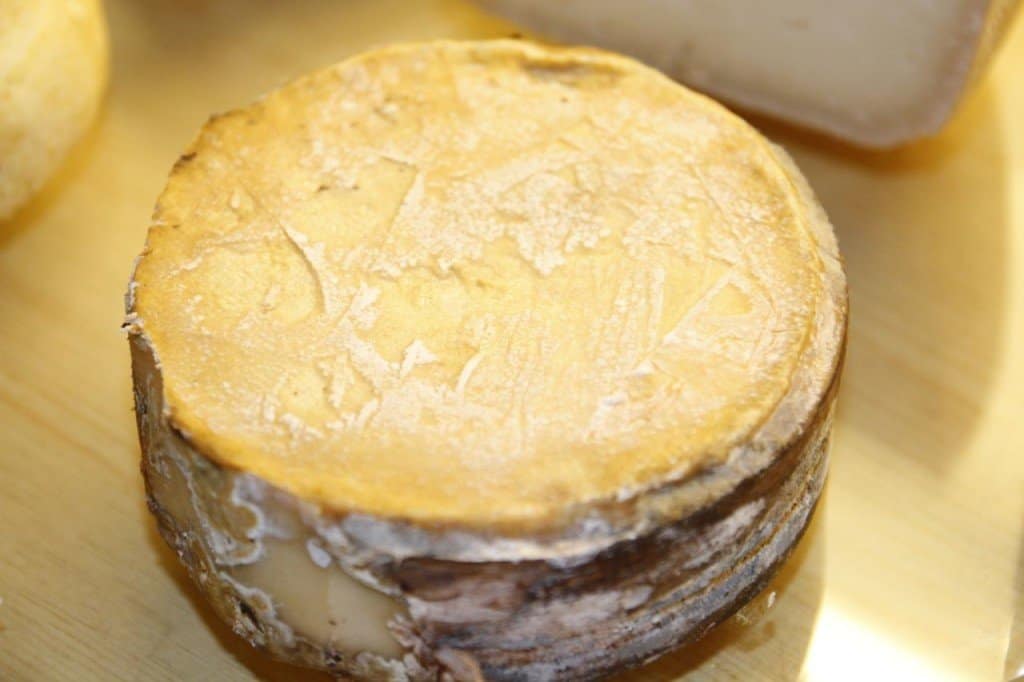
In pursuit of pleasure – that seems to be Mont d’Or. In the cheese world anyway. Somehow when one talks about a cult cheese it’s always Mont d’Or. There are various “king of the cheeses” but really only one cult cheese. For the Americans it’s possible Rogue River Blue takes that place. It springs to mind since the last edition has just been released. But as much as I love Mont d’Or, I must admit there are alternatives. More about that later.
Mont d’Or is a soft cheese coming from the Jura area in France and Switzerland respectively. The popular name for both is Mont d’Or, but the official name for the French variety is Vacherin du Haut-Doubs while the name of the Swiss one is Vacherin Mont d’Or. So be it even though the mountain Mont d’Or is on the French side of the border. These two varieties have much in common, but at least one difference. They are both soft, and most of us are familiar with the 480 grams boxed variant. Washed rind cheeses. Season is somewhat stricter for the French than the Swiss variety, the French being made from August 15 until March 15. In Switzerland, a little later in both ends. Sales season is from September 10th to May 10th, at least for the French cheese. For both cheeses they are made during the cool season as a substitute for making Comté in France and Gruyère in Switzerland.
Both cheeses have a PDO, or AOP as it will be in French. As it seems I have never seen the Swiss Mont d’Or other than in the small box. In France though you have more to choose from as you can get the cheese in sizes from 480 grams til 3.2 kilos. Diameter from 11 cm to 33, the latter very similar to Brie de Meaux in size and shape. The main difference between to two cheeses is that the French is made with raw cows’ milk while the Swiss is made with termized cows’ milk.
VACHERIN
In French, the term vacherin appears several places in the Franco-Provençal cultural area, from Franche-Comté to Savoie, passing through the French-speaking Switzerland. The Swiss Romand Dictionary (1997) notes the first occurrences in the 15th century on the Swiss side, while the Inventory of the Culinary Heritage of France, Rhône-Alpes (1995) and Franche-Comté (1993) volumes, quotes texts from the 14th and 15th centuries. There is no indication of the type of cheese to which this designation was applied then. (Patrimoine Culinaire Suisse)
Mont d’or – the alternatives
There are actually a few alternatives, underdogs if you like, not as famous as the Mont d’Or, but jus as tasteful if not better. That’s individual of course, but if you come across any of them I urge you to try. The other cheeses are not bound by the the Mont d’Or seasonality, but other seasons may apply.

Not to move too far away there is Vacherin d’Areches from the Savoie. Made with raw goats’ milk. They even use a Mont d’Or culture. It looks much alike, same area of use, but the season is different, more depending on the lactation period of the goats than legal regulations. Slightly more pungent than the Mont d’Or. From the area where they also make the Beaufort alpine cheese. It is a farmstead cheese, as far as I know made only at one farm.
From the same area, slightly further east in Haute-Savoie comes Vacherin d’Abondance. From the Dranse valley ending at the shores of laske Geneva. A farmstead cheese this as well, and very rare. Only a few tonnes made every year. This cheese is made with raw cows’ milk. Smooth, often eaten warm with potatoes and pickled vegetables or cold. The locals actually eat it cold.
In or along the Pyrenées we find another gem called Cabri Ariegeois. Made at a few farms in the Loubierès area of Occitanie. Had it a few times, in Norway, so its is not that rare. Could be serendipity of course it made it all the way up north, but probably someone knowing someone. My favourite this one.
Fluids to pair
Wine in my world, white wine. For the Mont d’Or Chardonnay pairs very well, whether it’s from Burgundy or the Jura is up to you. Just mentioning the Jura whites, which are excellent by the way, are local wines. What grows together goes together. That’s my obvious selection. Not just because they’re local, but as I said they stand out in their own right.
Same applies to the two Savoie cheeses. Savoie has very good wines, very underrated though. If you’re not familiar with Savoie wines, you should try some. Whites made with the Jacquère grape will pair very well.
For the Cabri Ariegeois you can choose a white Burgundy or you can go local with for instance a Pinet Picpoul. I always try to go local, and especially if I am there.
